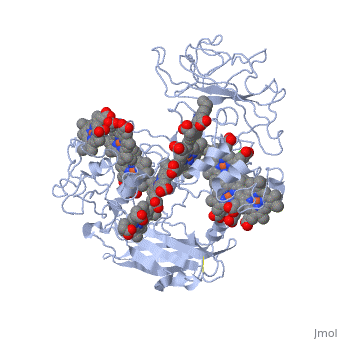Sandbox Reserved 386
From Proteopedia
(→'''General Information''') |
|||
| Line 12: | Line 12: | ||
== '''General Information''' == | == '''General Information''' == | ||
| - | MtrF is a cell surface cytochrome on the Gram-negative bacteria known as ''Shewanella oneidensis''.<ref name="mtrf"> PMID:11418600</ref> MtrF is involved with shuttling electrons across its (''S. oneidensis'') outer surface. MtrF has several homologues, MtrC and the protein OmcA. These three different proteins are thought to be replaceable with one another in deletion mutation experiments. <ref name= "mtrf" /ref> | + | MtrF is a cell surface cytochrome on the Gram-negative bacteria known as ''Shewanella oneidensis''..<ref name="mtrf"> PMID:11418600</ref> MtrF is involved with shuttling electrons across its (''S. oneidensis'') outer surface. MtrF has several homologues, MtrC and the protein OmcA. These three different proteins are thought to be replaceable with one another in deletion mutation experiments.<ref name= "mtrf" /ref> |
== '''MtrF Function''' == | == '''MtrF Function''' == | ||
| Line 20: | Line 20: | ||
== '''MtrF Structure''' == | == '''MtrF Structure''' == | ||
| - | MtrF contains a few common <scene name='Sandbox_Reserved_386/Elements/2'>elements</scene>; O,N,Fe and Ca. Oxygen is the most abundant element and is spread out through the entire protein. There are several nitrogens that form rings that have an iron placed in the center. There is also a lone calcium ion. There are <scene name='Sandbox_Reserved_386/Alpha_beta/1'>alpha helices and beta sheets</scene> positioned throughout MtrF, there are more alpha helices but they are randomly placed in the structure while there are fewer beta sheets and they are located on opposite ends from one another. MtrF as mentioned above is a decaheme cytochrome, which means that there are ten heme groups that are spatially organized throughout the protein. Each heme is spread about 7Å from its neighbor, this close space allows for speedy electron transfer. The (ten) hemes are organized across four domains in a distinctive cross conformation | + | MtrF contains a few common <scene name='Sandbox_Reserved_386/Elements/2'>elements</scene>; O,N,Fe and Ca. Oxygen is the most abundant element and is spread out through the entire protein. There are several nitrogens that form rings that have an iron placed in the center. There is also a lone calcium ion. There are <scene name='Sandbox_Reserved_386/Alpha_beta/1'>alpha helices and beta sheets</scene> positioned throughout MtrF, there are more alpha helices but they are randomly placed in the structure while there are fewer beta sheets and they are located on opposite ends from one another. MtrF as mentioned above is a decaheme cytochrome, which means that there are ten heme groups that are spatially organized throughout the protein. Each heme is spread about 7Å from its neighbor, this close space allows for speedy electron transfer. The (ten) hemes are organized across four domains in a distinctive cross conformation. All of the hemes in the MtrF crystal structure display bis-His axial ligand coordination. The His residue in the domains provide the distal ligands for the five hemes in the same domain. Domains I and III contain antiparallel Beta-strands that connect two Greek key split Beta-barrel domains. Domains II and IV bind five closely packed hemes covalently attached Cys residues to the motifs in each domain. All the domains fold together so that the pentaheme domains II and IV are crowded together to form a central core with the two barrel domains I and III adjoining either side. The 3.2Å crystal structure proposes that the hemes, each corresponding to two His ligands, are near enough for effective electron transfer. Near-infrared magnetic circular dichroism and electron paramagnetic resonance spectroscopy provide additional support for these structural features. The complete structure of MtrF is similar to an ellipsoid with dimensions of 85x70x30Å. This particular structure was able to provide molecular insight into how the reduction of insoluble substrates, soluble substrates, and cytochrome redox partners may be possible together at different termini on an electron transport chain on the cell surface.<ref name="mtrf" /> |
Revision as of 19:52, 8 December 2011
| This Sandbox is Reserved from September 14, 2021, through May 31, 2022, for use in the class Introduction to Biochemistry taught by User:John Means at the University of Rio Grande, Rio Grande, OH, USA. This reservation includes 5 reserved sandboxes (Sandbox Reserved 1590 through Sandbox Reserved 1594). |
To get started:
More help: Help:Editing. For an example of a student Proteopedia page, please see Photosystem II, Tetanospasmin, or Guanine riboswitch. |
|
Contents |
MtrF
General Information
MtrF is a cell surface cytochrome on the Gram-negative bacteria known as Shewanella oneidensis..[1] MtrF is involved with shuttling electrons across its (S. oneidensis) outer surface. MtrF has several homologues, MtrC and the protein OmcA. These three different proteins are thought to be replaceable with one another in deletion mutation experiments.[1]
Regulation of MtrF
A prime example of MtrF regulation is the study of "Regulation of MtrF Expression in Neisseria gonorrhoeae and Its Role in High-Level Antimicrobial Resistance".[2] In this study the expression of MtrF was repressed by MtrR (the major repressor in the mtrCDE expression). Another repressor known as MpeR can also regulate the expression of MtrF. Repression of MtrF by MtrR and MpeR was used, demonstrating that the repressive effects mediated by these regulators are independent processes. MtrF was also disabled and the significant reduction in the induction of hydrophobic agent resistance and it was found that the expression of MtrF is enhanced when Gonococci are grown under inducing conditions.
References
- ↑ 1.0 1.1 Fotinou C, Emsley P, Black I, Ando H, Ishida H, Kiso M, Sinha KA, Fairweather NF, Isaacs NW. The crystal structure of tetanus toxin Hc fragment complexed with a synthetic GT1b analogue suggests cross-linking between ganglioside receptors and the toxin. J Biol Chem. 2001 Aug 24;276(34):32274-81. Epub 2001 Jun 19. PMID:11418600 doi:10.1074/jbc.M103285200
- ↑ Folster JP, Shafer WM. Regulation of mtrF expression in Neisseria gonorrhoeae and its role in high-level antimicrobial resistance. J Bacteriol. 2005 Jun;187(11):3713-20. PMID:15901695 doi:10.1128/JB.187.11.3713-3720.2005

